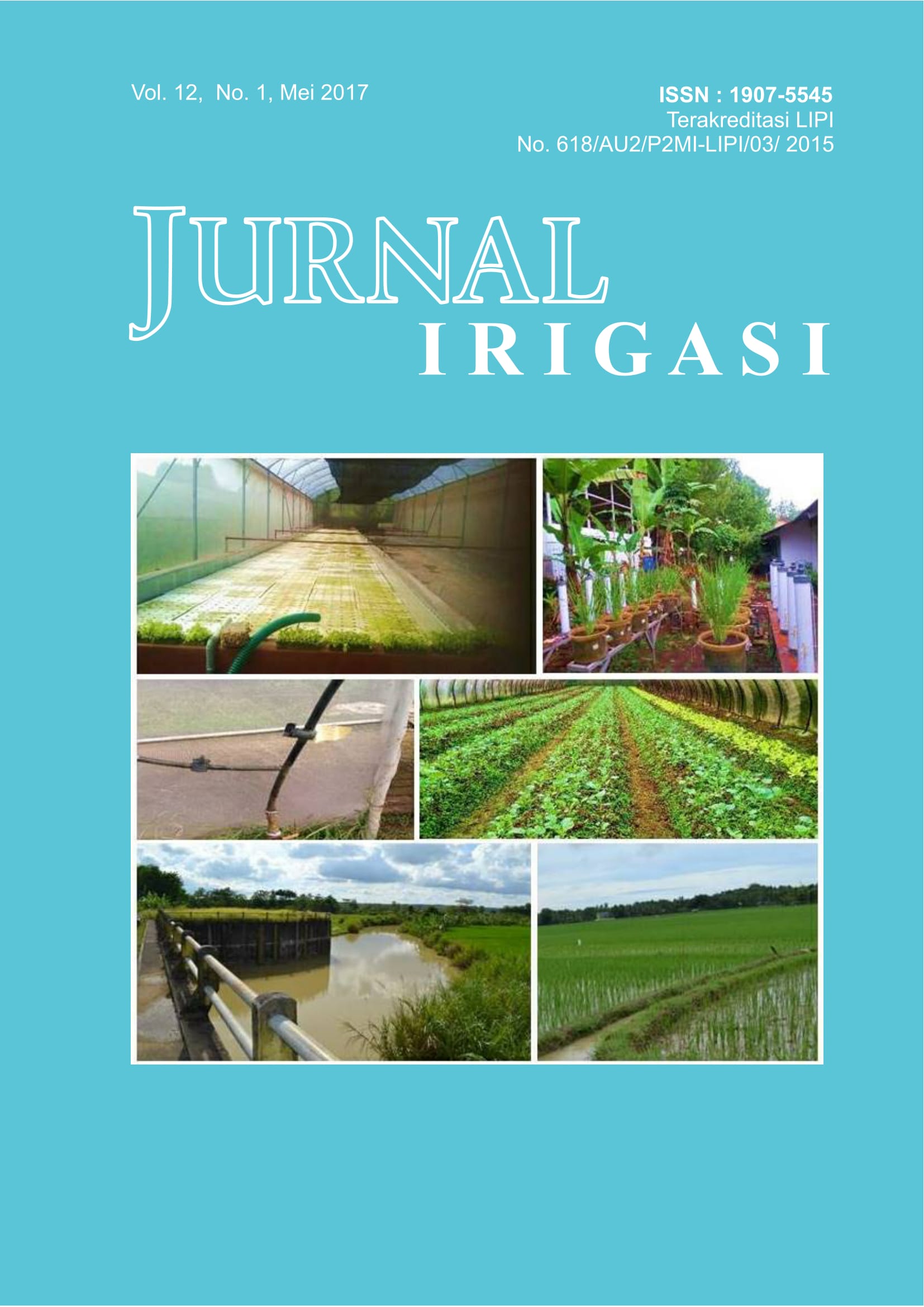Analisis konsumsi air sayuran organik dalam rumah tanaman
DOI:
https://doi.org/10.31028/ji.v12.i1.37-46Kata Kunci:
budidaya sayuran, irigasi, kadar air tanah, konsumsi air, rumah tanamanAbstrak
Sayuran organik yang dibudidayakan di rumah tanaman memerlukan pengaturan pemberian air irigasi untuk mempertahankan kadar air tanah berdasarkan fase tumbuh tanaman. Salah satu kendala dalam pemberian irigasi adalah tidak adanya parameter yang digunakan untuk menentukan jadwal dan jumlah  air irigasi yang diberikan. Penelitian ini dilaksanakan untuk mengetahui apakah pelaksanaan irigasi  yang digunakan di lahan penelitian dapat memenuhi kebutuhan air tanaman serta jumlah konsumsi airnya berdasarkan pendekatan perubahan kadar air. Pada penelitian ini dilakukan pengamatan kelembaban tanah setiap hari dan menganalisis aliran air tanah berdasarkan parameter sifat fisik dan hidrolika tanah. Hasil penelitian menunjukkan bahwa kadar air tanah berada diantara kapasitas lapang dan titik layu permanen namun  87% dari masa tanam  berada dibawah nilai readily avaiable water (RAW). Kondisi ini menunjukkan pemberian air irigasi pada lahan penelitian masih belum sepenuhnya optimal. Berdasarkan analisis perubahan kadar air tanah, konsumsi air selama masa tanam sayuran kailan  di lahan penelitian adalah 55 mm selama masa tanam dengan laju konsumsi air 1,1 mm/hari. Kebutuhan air di lahan penelitian untuk mencapai kondisi RAW adalah 130 mm.
Unduhan
Referensi
Adams HD, Luce CH, Breshears DD, Allen CD, Weiler M, Hale VC, Smith A, Huxman TE. 2012. Ecohydrological Consequences of Drought and Infestation Triggered Tree Die Off: Insights and Hypotheses. Ecohydrology 5(2): 145-159.
Agustina L. 2011. Budidaya Sayuran Organik: Skala Rumah Tangga Menuju Standar Sertifikasi Pangan Organik. Malang Malang (ID): Universitas Brawijaya.
Andoko A. 2002. Budidaya Padi Secara Organik. Jakarta (ID): Penebar Swadaya.
Arif C, Setiawan BI, Mizoguchi M. 2014. Penentuan Kelembaban Tanah Optimum untuk Budidaya Padi Sawah SRI (System of Rice Intensification) menggunakan Algoritma Genetika. Jurnal Irigasi 9(1): 29-40.
Askari M, Saptomo SK, Setiawan BI. 2014. Error Analysis on the Estimation of Cumulative Infiltration Soil using Green and Ampt model. Jurnal Keteknikan Pertanian 20(2).
Christen E, Ayars J, Hornbuckle J, Hickey M. 2006. Technology and Practice for Irrigation in Vegetables. State of New South Wales (AU): NSW Department of Primary Industries.
[DEPTAN] Departemen Pertanian. 2007. Pedoman Penyusunan Standar Operasi (SPO) Padi Organik. [diunduh 2016 9 desember]
Fauziah R, Susila AD, Sulistyono E. 2016. Budidaya Bawang Merah (Allium ascalonicum L.) pada Lahan Kering Menggunakan Irigasi Sprinkler pada berbagai Volume dan Frekuensi. Jurnal Hortikultura Indonesia 7(1).
Genuchten MTV. 1980. A Closed-form Equation for Predicting the Hydraulic Conductivity of Unsaturated Soils. Soil Science Society of America Journal 44(5): 892-898.
Kasiran. 2012. Teknologi Irigasi Tetes "Ro Drip" untuk Budidaya Tanaman Sayuran di Lahan Kering Dataran Rendah. Jurnal Sains dan Teknologi Indonesia 8(1).
Mualem Y. 1976. A New Model for Predicting the Hydraulic Conductivity of Unsaturated Porous Media. Water Resources Research 12(3): 513-522.
Muzayyanah. 2009. Pengaruh Pemberian Pupuk Bokashi terhadap Pertumbuhan Tanaman Sawi (Branssica juncea L.) [Skripsi]. Malang (ID): Universitas Islam Negeri Maulana Malik Ibrahim.
Nikolidakis S, Kandris D, Vergados D, Douligeris C. 2015. Energy efficient automated control of irrigation in agriculture by using wireless sensor networks. Computers and Electronics in Agriculture 113: 154-163.
Salokhe V, Babel M, Tantau H. 2005. Water Requirement of Drip Irrigated Tomatoes Grown in Greenhouse in Tropical Environment. Agricultural Water Management 71(3): 225-242.
Setiawan B, Ilstedt U, Malmer A. 2007. Numerical Solutions of Water Flow in Unsaturated Soils. Swedia (SE): Department of Forest Ecology of Swedish University of Agricultural Scienes.
Setiawati W, Murtiningsih R, Sophia G, Handayani T. 2007. Budidaya Tanaman Sayuran. Bandung (ID): Balai Penelitian Tanaman Sayuran.
Simangunsong FT, Sumono S, Rohana A, Susanto E. 2013. Drip Irrigation Efficiency Analysis and Crop Water Requirements of Mustard (Brassica juncea) in The Inceptisol Soil. Jurnal Rekayasa Pangan dan Pertanian 1(2): 83-89.
Sumarni N, Muharam A. 2005. Budidaya Tanaman Cabai Merah. Bandung (ID): Balai Penelitian Tanaman Sayuran.
Winarbawa S. 2000. Pengaruh kadar air tanah terhadap pertumbuhan dan produksi dua tipe kapolaga sabrang. Jurnal Agronomi Indonesia (Indonesian Journal of Agronomy) 28(1).
Yanto H, Tusi A, Triyono S. 2014. Aplikasi Sistem Irigasi Tetes pada Tanaman Kembang Kol (Brassica Oleracea Var. Botrytis L. Subvar. Cauliflora DC) dalam Greenhouse. Jurnal Teknik Pertanian Lampung 3(2): 141-154.
Unduhan
Diterbitkan
Cara Mengutip
Terbitan
Bagian
Lisensi
Naskah dilisensikan berdasarkan Creative Commons Attribution-ShareAlike 4.0 International License.
